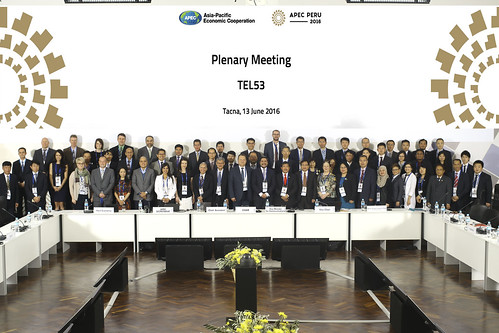
Kevon Swift, Head of Strategic Relations and Integration for the Latin American and Caribbean Internet Addresses Registry (LACNIC), recently attended APEC TEL 53, held in Tacna, Peru via APNIC’s guest status at APEC TEL, as APNIC’s sister organisation. LACNIC is also responsible for APEC members from Peru, Chile and Mexico.
I recently had the pleasure of participating at the 53rd Asia-Pacific Economic Cooperation Telecommunications and Information Working Group meeting – APEC TEL 53 – held in Tacna, Peru through an arrangement with my APNIC colleagues and at the kind invitation of APEC Member economies.
The meeting gave me a lot of insight into interactions and policy making for the digital economy among Asian economies, significant OECD Members, and well-reputed ICT industry players. Suffice to say, not many other groups can possibly boast such a forthcoming, collaborative ethos as this one!
My experience began with a crash course on APEC TEL’s modus operandi, or rather its diplomacy, which after a few meeting sessions resembled the proceedings of many other intergovernmental organizations. The twist for me was that all participants made a very conscious effort to shape “TEL” as a community of practice with minimal political sway.
As one of only two representatives of the technical community present at the meeting (a colleague from the Internet Society also participated), I celebrated the ethos of building dialogue from the bottom-up, on equal footing and based on demonstrated interest. By now, depending on the meetings we frequent, some of us take this approach for granted but that should not be the case.
I started off by observing the Industry Roundtable of the ICT Development Steering Group (DSG) in which representatives from, inter alia, Intel, NEC, Bquate and Telefonica del Peru presented on various ICT applications. They addressed cloud computing, Smart Cities enabled by IoT, artist management and promotion, and business strategies for IPv6 adoption. Similar to the Liberalisation Steering Group’s Industry Roundtable (LSG – IR) on the following day, this space highlighted trends and test cases from various parts of the world and gave participants the opportunity to ask difficult questions related to localization, incorporating contextual knowledge and implementing setbacks for each of the ICT projects.
DSG also convened another type of session – presentations from government actors – entitled, “Facilitating innovative economic development of ‘Internet+Service’ Industry”. Here we saw representatives from Peru, Japan and the US among others sharing data on ICT deployment, e-commerce and regulatory trends, and general governance issues for disruptive technologies and sharing economy models.
In the DSG Plenary Session, I had the opportunity to build on my APNIC colleague’s narrative vis-à-vis non-technical arguments supporting IPv6 adoption. LACNIC spent most of 2015 working on an IPv6 KPI we call LACNIC ICAv6, in which we proposed a methodology for measuring IPv6 deployment along various stages of the Internet value chain. While for the most part this is fashioned using Cisco’s methodology on measuring IPv6 adoption, LACNIC’s innovation is based on a weighting system to look at the issues of real versus potential IPv6 deployment.
With TEL, I shared the findings of our research, documented case studies of the success stories we saw in the Latin American and Caribbean region, and clear guidelines that emerged from that experience. Needless to say, these guidelines reiterated APNIC’s work with APEC TEL’s 2010 IPv6 Guidelines (doc, 224KB), and provided additional practical information that can help decision makers develop IPv6 adoption strategies.
By the end of the week I left APEC TEL 53 with a number of connections made, a sound understanding of APEC’s work in developing the digital economy, and a great sense of admiration for the group’s dynamics and resolve. We certainly look forward to more opportunities for building knowledge within the TEL group, and future joint actions with our APNIC colleagues.
For more information on our IPv6 research, visit LACNIC’s IPv6 research portal.
Kevon Swift is Head of Strategic Relations and Integration for the Latin American and Caribbean Internet Addresses Registry (LACNIC).
The views expressed by the authors of this blog are their own and do not necessarily reflect the views of APNIC. Please note a Code of Conduct applies to this blog.

